radiator cap AUDI S6 2008 Owners Manual
[x] Cancel search | Manufacturer: AUDI, Model Year: 2008, Model line: S6, Model: AUDI S6 2008Pages: 390, PDF Size: 88.42 MB
Page 35 of 390
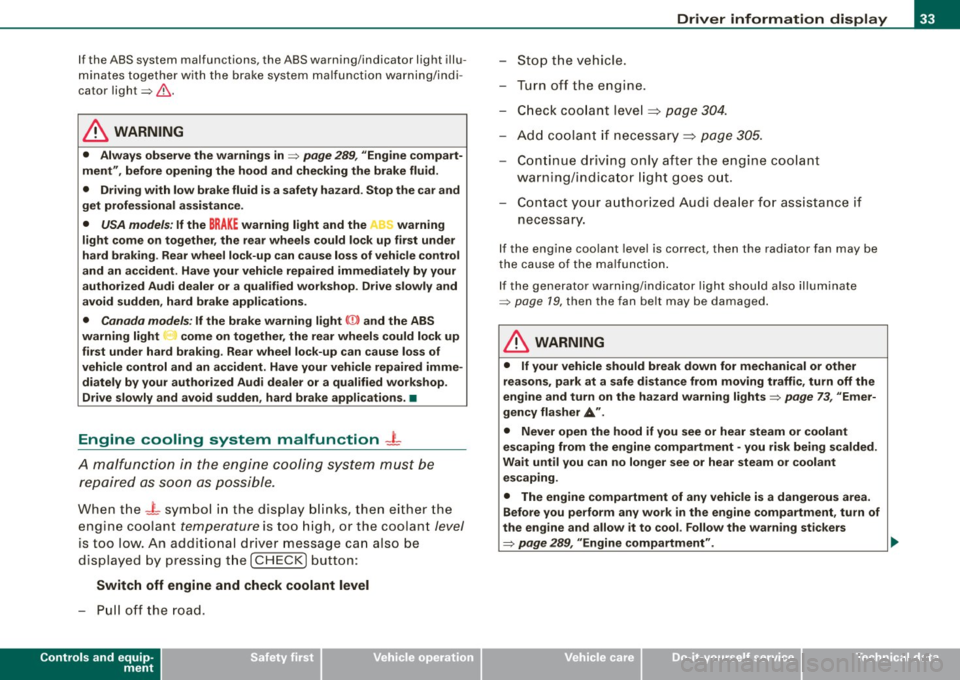
If the ABS system malfunctions, the ABS warning/indicator light illu
minates together with the brake system malfunction warning/indi
cator light~
&-
& WARNING
• Always observe the warnings in ~ page 289, "Engine compart
ment", before opening the hood and checking the brake fluid.
• Driving with low brake fluid is a safety hazard . Stop the car and
get professional assistance.
• USA models: If the
BRAKE warning light and the c~ warning
light come on together, the rear wheels could lock up first under
hard braking . Rear wheel lock-up can cause loss of vehicle control
and an accident. Have your vehicle repaired immediately by your
authorized Audi dealer or a qualified workshop. Drive slowly and
avoid sudden, hard brake applications.
• Canada models : If the brake warning light
«D> and the ABS
warning light come on together, the rear wheels could lock up
first under hard braking. Rear wheel lock-up can cause loss of
vehicle control and an accident. Have your vehicle repaired imme
diately by your authorized Audi dealer or a qualified workshop .
Drive slowly and avoid sudden, hard brake applications. •
Engine cooling system malfunction -L
A malfunction in the engine cooling system must be
repaired as soon as possible.
When the -t symbol in the display blinks, then either the
engine coolant
temperature is too high, or the coolant level
is too low. An additional driver message can also be
displayed by pressing the [ CHECK] button:
Switch off engine and check coolant level
-Pull off the road .
Controls and equip
ment
Driver information display
Stop the vehicle.
- Turn off the engine.
Check coolant level
=> page 304 .
Add coolant if necessary=> page 305.
Continue driving only after the engine coolant
warning/ind icator light goes out.
Contact your authorized Audi dealer for assistance if necessary.
If the engine coolant level is correct, then the radiator fan may be
the cause of the malfunction.
If the generator warning/indicator light should also illuminate
~ page 79, then the fan belt may be damaged.
& WARNING
• If your vehicle should break down for mechanical or other
reasons, park at a safe distance from moving traffic, turn off the
engine and turn on the hazard warning lights
~ page 73, "Emer
gency flasher
A".
• Never open the hood if you see or hear steam or coolant
escaping from the engine compartment -you risk being scalded.
Wait until you can no longer see or hear steam or coolant
escaping.
• The engine compartment of any vehicle is a dangerous area.
Before you perform any work in the engine compartment, turn of
the engine and allow it to cool. Follow the warning stickers
~ page 289, "Engine compartment" . .,_
I • •
Page 299 of 390
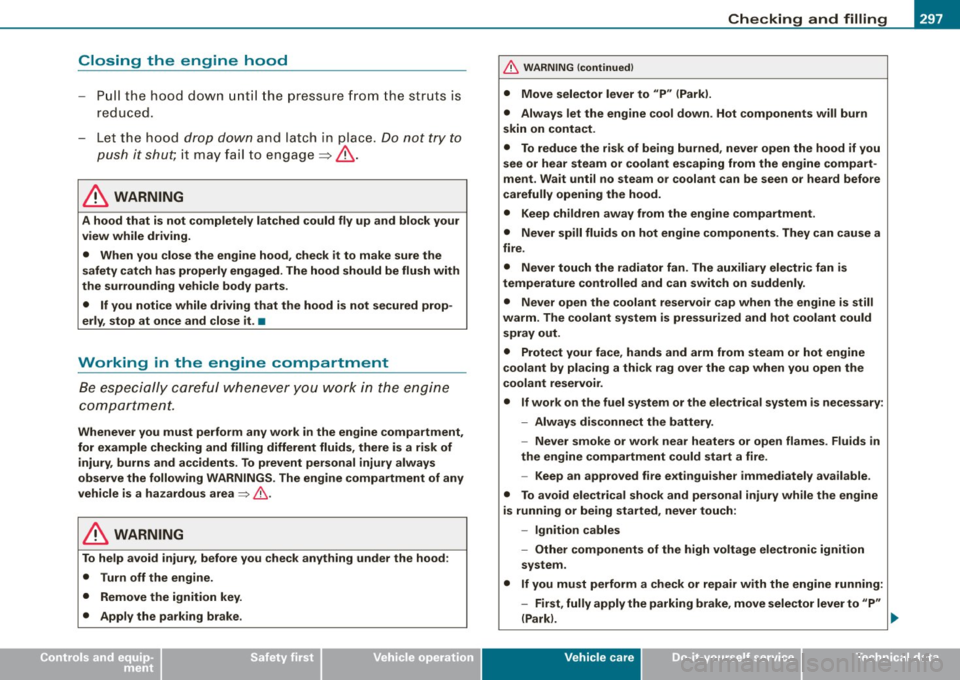
___________________________________________ C_ h:....:e :....: c:....: k..:..: i..:.. n :..::g ::.....:: a:..:.n ..:..: d=---.:. f..:..:il ..:..:li ..:..n :.:::g !--_!11
•
Closing the engine hood
- Pull the hood down until the pressure from the struts is
reduced .
- Let the hood
drop down and latch in place. Do not try to
push it shut;
it may fail to engage => &.
& WARNING
A hood that is not completely latched could fly up and block your
view while driving.
• When you close the engine hood, check it to make sure the
safety catch has properly engaged. The hood should be flush with
the surrounding vehicle body parts.
• If you notice while driving that the hood is not secured prop
erly, stop at once and close it. •
Working in the engine compartment
Be especially careful whenever you work in the engine
compartment.
Whenever you must perform any work in the engine compartment,
for example checking and filling different fluids, there is a risk of injury, burns and accidents. To prevent personal injury always
observe the following WARNINGS. The engine compartment of any
vehicle is a hazardous area
~ & .
& WARNING
To help avoid injury, before you check anything under the hood :
• Turn off the engine.
• Remove the ignition key.
• Apply the parking brake .
& WARNING (continued)
• Move selector lever to "P" (Park).
• Always let the engine cool down. Hot components will burn
skin on contact.
• To reduce the risk of being burned, never open the hood if you
see or hear steam or coolant escaping from the engine compart
ment. Wait until no steam or coolant can be seen or heard before
carefully opening the hood.
• Keep children away from the engine compartment .
• Never spill fluids on hot engine components. They can cause a
fire.
• Never touch the radiator fan. The auxiliary electric fan is
temperature controlled and can switch on suddenly.
• Never open the coolant reservoir cap when the engine is still
warm . The coolant system is pressurized and hot coolant could
spray out.
• Protect your face, hands and arm from steam or hot engine
coolant by placing a thick rag over the cap when you open the
coolant reservoir.
• If work on the fuel system or the electrical system is necessary :
- Always disconnect the battery.
- Never smoke or work near heaters or open flames . Fluids in
the engine compartment could start a fire.
- Keep an approved fire extinguisher immediately available.
• To avoid electrical shock and personal injury while the engine
is running or being started, never touch:
- Ignition cables
- Other components of the high voltage electronic ignition system.
• If you must perform a check or repair with the engine running: -First, fully apply the parking brake, move selector lever to "P"
(Park). .,
Vehicle care
I t •
Page 300 of 390
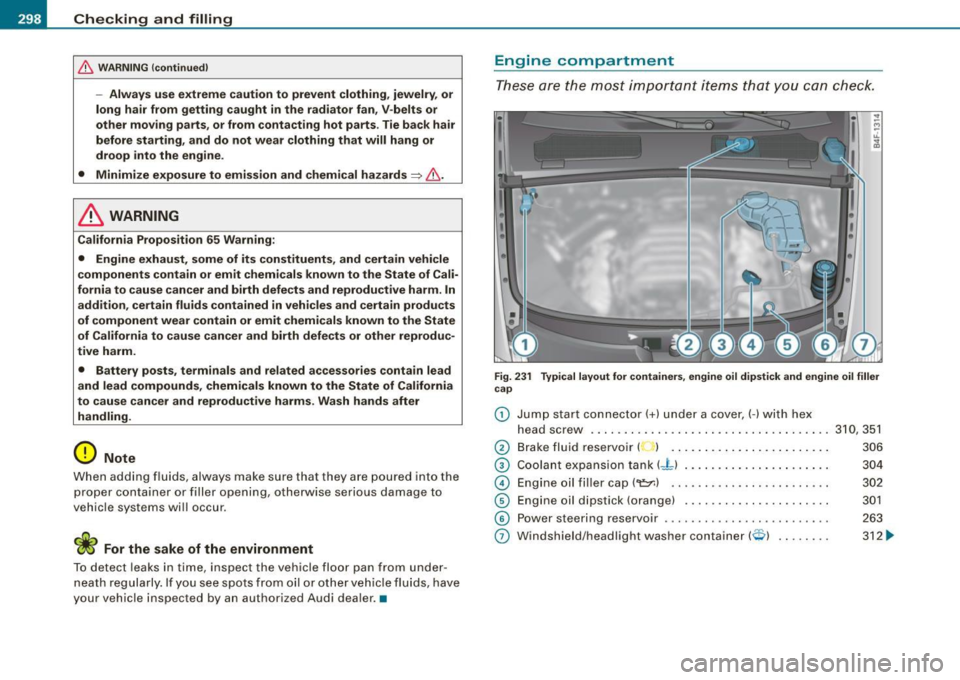
___ C_h_ e_ c_k _in --== g'-- a_n _d_ f_il _li _n ..:::g:::..- ___________________________________________ _
& WARNING (continued )
-Always u se extreme caution to prevent cloth ing , jewelry, or
long hair from getting caught in the radiator fan , V-belt s or
other moving parts , or from contacting hot parts . Tie back hair
before starting , and do not wear clothing that will hang or
droop into the engine .
• Minimize exposure to emis sion and chemical hazards
::::> & .
& WARNING
California Proposition 65 W arn ing :
• Engine exhaust , some of its constituents , and certain vehicle
c omponents cont ain or emit chemicals known to the State of Cali
fornia to cause cancer and birth defects and reproductive harm. In addition , certain fluids contained in vehi cles and certa in products
of component wear contain or emit chemicals known to the State
of California to cause cancer and birth defect s or other reprodu c
tive harm.
• Battery posts , terminals and related ac cessories conta in lead
and lead compounds , chemicals known to the State of California
to cause cancer and reproductive harms. Wash hands after
handling.
0 Note
When adding f luids, always make sure that they are poured into the
proper container or filler ope ning, otherwise serious damage to
vehic le systems wi ll occur.
ci> For the sake of the environment
To detect leaks in time, inspect the vehicle floor pan from under
n eath regu larly. If you see spots fro m oil o r o th e r v eh icle flu ids, hav e
your vehicle inspected by an author ized Audi dea ler. •
Engine compartment
These are th e m ost im porta nt items th at you can ch ec k.
Fig. 231 Typical layout for containe rs, engine oi l d ipstick and engine oil filler
cap
0 Jum p star t connector( +) under a cover,( -) w ith hex
head screw .... ... .... ..... ... .. .. ........... .. 310, 351
@ B rake fluid reservoir ( ) . . . . . . . . . . . . . . . . . . . . . . . . 3 06
© Coo lant e xpansio n tank (- L ) . . . . . . . . . . . . . . . . . . . . . . 304
© Eng in e oil fill er cap ('l=:11) . . . . . • . . . . . . • . . . • . . . . . . . 30 2
© E ng ine oil d ipstick (orange) .............. ....... .
©
0
Power steering reservoir ....................... •.
Windshield/ headlight washer container( ~) ....... . 3
01
263
312 ~
Page 307 of 390
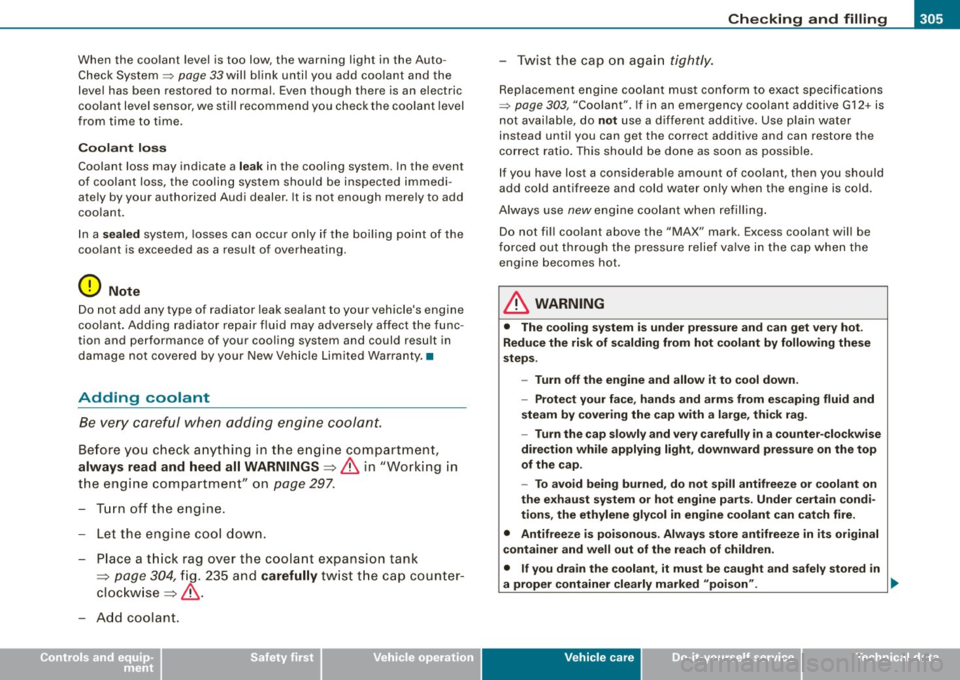
_____________________________________________ C_h_ e_ c_k _in ~ g_ a_n _d_ f_il _li _n ~g __ _
•
When the coolant level is too low , the warning light in the Auto
Check System =>
page 33will blink un til you add coo lant and the
level has been restored to normal. Even though there is an electric
coolant leve l sensor, we still recommend you check the coo lant level
from time to time .
Coola nt lo ss
Coolant loss may indicate a leak in the cooling system . In the event
of coolant loss, the coo ling sys tem should be inspected immedi
ately by your authorized Audi dealer . It is not enough merely to add
coolant.
In a
s ealed system, losses can occur only if the boiling po int of the
coolant is exceeded as a result of overheating.
0 Note
Do not add any type of radiator leak sea lant to your vehicle's engine
coolant . Adding radiator repair fluid may adversely affect the func
tion and performance of your cooling system and could resu lt in
damage not covered by your New Vehic le Limited War ranty .•
Adding coolant
Be very careful when adding engine coolant.
Before you check anything in the engine compartment,
always read and heed all WARNINGS => & in "Working in
the engine compartment" on
page 297 .
- Tu rn off the engine .
- L et the engine coo l dow n.
- Place a t hick rag over the coolant expansion tank
=> page 304, fig . 235 and carefully tw ist t he cap counter
cloc kw ise
=> & .
- Add coolant. - Twist the cap
on agai n
tightly.
Replacement engine coolant must conform to exact specifications
=>
page 303, "Coolant". If in an emergency coolant additive G12 + is
not avai lable, do
not use a different additive . Use p lain water
instead until you can get the correct additive and can restore the
correct ratio . This should be do ne as soon as possible.
If you have lost a considerable amount of coolant, then you should
add cold antifreeze and cold water only when the engine is cold .
Always use
new engine coolant when refilling .
Do not fil l coolant above the "MAX" mark. Excess coolant will be
forced out through the pressure relief va lve in the cap when the
engine becomes ho t.
& WARNING
• The cooling system is under pressure and can get ver y hot.
Redu ce the risk of sc alding from hot coolan t by follow ing the se
s tep s.
- Turn off th e en gine and allo w it to cool down .
- Protect your fa ce , ha nd s and arm s from e sc a pi ng fluid and
s tea m by cov ering the c ap with a large , thick rag.
- Tur n the cap slo wly an d very ca refully in a counter -clockw is e
dire ction whil e applying light , downward pres sure on the top
o f the cap.
- To av oid bei ng burn ed , do n ot spill antifree ze or cool ant on
the e xhau st sy stem or h ot e ngi ne part s. Under cert ain co ndi
tion s, the ethylen e gl ycol in engin e co olant c an c atch fire .
• Antifr eeze is po iso nous. Alwa ys store antifree ze in its or igin al
c ontainer and well out of the reach of c hildren .
• If you dra in t he coola nt, it mu st b e ca ught and sa fel y stor ed in
a prop er container clearly mark ed "poi son ".
~
Vehicle care I t •
Page 308 of 390
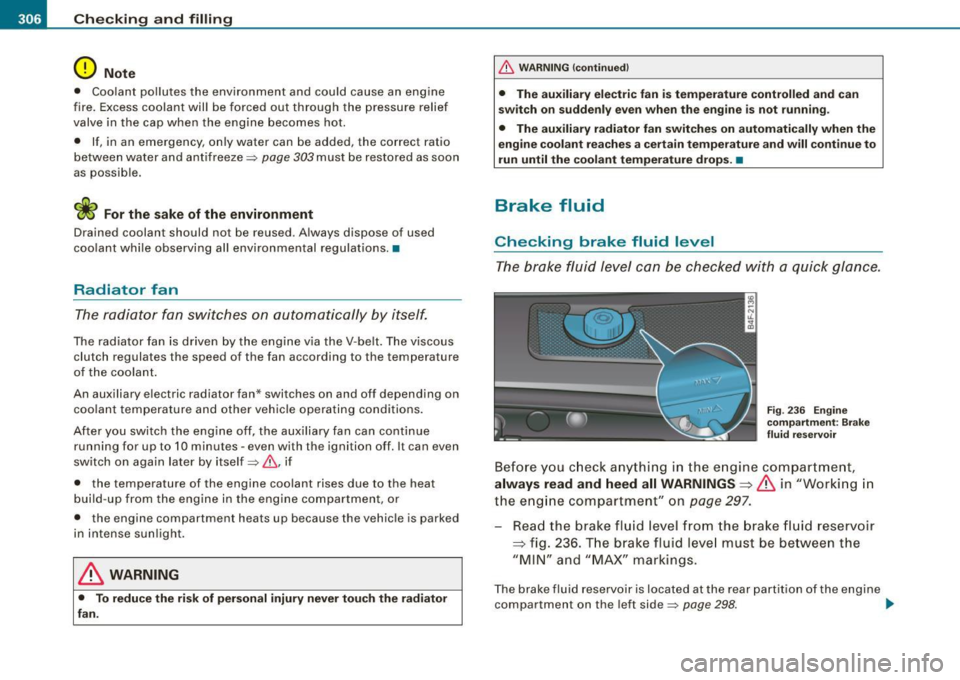
•---=C:.:h..:. e=-= c..:.k :..:.in :..:.:= g:.....= a..:.n :.:d::....:. f.:.:il .:.:li ..:.n :..::g~ --------------------------------------------
0 Not e
• Coolant pollutes the environment and cou ld cause an engine
fire. Excess coolant will be forced out through the pressure relief
valve in the cap when the engine becomes hot.
• If, in an emergency, only water can be added, the correct ratio
between water and antifreeze ~
page 303 must be restored as soon
as possible .
ci> For the sake of the environment
Dra ined coolant should not be reused . Always dispose of used
coolant whi le observing all environmental regulations. •
Radiator fan
The radiator fan switches on automatically by itself.
The rad iator fan is driven by the eng ine v ia the V-be lt . The v iscous
clutch regulates the speed of the fan according to the tempera ture
of the coo lant .
An auxiliary electric radiator fan * swi tches on and off depending on
coo lant temperature and other vehicle operating conditions.
After you switch the engine off, the auxiliary fan can continue running for up to 10 minut es -even with th e igni tion o ff. It can even
switch o n again later by itself~ & , if
• the temperature of the engine coo lant rises due to the heat
bui ld -up from the engine in the engine compartment, o r
• the engine compartment heats up because the vehic le is parked
in intense sun light.
& WARNING
• To reduce the ri sk of per sonal injury never tou ch the radiator
f a n.
& W AR N ING (continu ed )
• The auxiliary e le ctri c fan i s temperature controlled and can
s w itch on suddenly even when the engine is not running .
• The auxiliary radiator fan swit ches on automatically when the
engine coolant reache s a ce rtain temperature and will con tinue to
run until the coolant t emperatur e drop s. •
Brake fluid
Checking brake fluid level
Th e brake fluid level c an be checked with a quick glance.
Fig . 23 6 En gin e
co mp art m ent : B ra ke
fl uid re servoir
Befo re yo u c heck anything in th e en gin e compar tme nt,
always read and heed all WARNINGS~ & in "Working in
the eng ine compartment" on
page 297 .
Rea d the brake fl uid level from the bra ke fluid reservoir
~ fig . 236. T he b rake fluid leve l must be betwee n the
" M IN " and "MAX" markings.
The brake fluid reservoir is located at the rear parti tion of the engine
compartment on the left side~
page 298. .,_
Page 379 of 390

______________________________________________ A_ l_,_ p _h_ a_ b_e _t_i c_ a _ l _in _ d_e _ x __ ftllll
Proper disposal of drained engine oil 302
Recycling used engine oil ..... ..... 302
Un leaded fuel ..... ....... .... ... . 291
What should I do with an old battery?
311
EPC
See Electronic power control . .... ... 19
ESP
See Electronic stabilization program
(ESP) ..... ... .. .... .... ...... ... 19
Event Data Recorder (EDR) ... .... ..... 258
Expansion tank ...... ....... ........ 304
Exterior lighting in the mirror housing ... 73
Eyeglasses compartment ............. 108
F
Fan
Radiator .............. .......... 306
Fastening eyelets ...... .... .......... 97
Flat tire Changing ... ... ... .. .... ...... .. 338
Floor mats . . . . . . . . . . . . . . . . . . . . . . . . . 198
Fog lights .... .... .... ... .. .... .... .. 72
Fo lding master key with remote contro l . 48
Foot pedals ...... .. .... .... ..... ... 198
For the sake of the environment Gasoline fumes and the environment 293
Letting you r engine warm up ...... . 125
Reducing engine noise by early
upshifting .. ...... ..... .... ... .. 13
Refuel ing .... .... ....... .... .... 293
Controls and equip
ment Safety first
Saving
fuel by early upshifting .... .. 13
Usingtherearwindowdefogger .. .. 117
Front airbags
Description ......... .... .... .... . 216
How they work .... ........ ....... 221
Front arm rest adjusting . ...... .... .... ... .... ... 96
Storage compartment ... .... ..... .. 96
Front ashtray .... .... .... ........ ... 104
Front fog lights ..... ........ .... .... . 72
Front seats .. ............ .... ....... . 87
Adjusting ... ....... .... .... .... . 195
Child restraints in the front seat ... . 214
Fronta l collisions and the laws of physics
203
Fuel Additives ... .. ...... .... ..... .... 291
Blended gasoline .... ....... .... .. 291
Consumption ....... .... .... .... .. 40
Fi ller neck ......... .. ... .... .... . 292
Fuel gauge ... .. .... .... ...... .... 15
Gasoline .. .... ... .... .... .... ... 291
Gasoline additives ................ 292
Low fuel level .............. .... 15, 36
Octane rating .................... 291
Recommendation ....... ... ... ... 291
Refuel ling .............. ...... ... 293
Reserve .......................... 15
Tank capacity .... .... ... .... .... . 363
Un locking the fue l f iller flap by hand 295
Fuse arrangement ............. ...... 345 G
Garage door opener (HomeLink®) . .... . 186
Gas discharge lamps . .... ........... . 349
Gauges Engine coolant temperature .. .. .. . .. 13
Fuel gauge ..... .... .. .. . ... ...... 15
Speedometer ... .... ... .. .... ..... 15
Tachometer . .... .... .... .... ...... 14
Trip odometer ... .. .... .... ... .. .. . 15
General illustration Instruments and controls ... .. .... .. 11
Generator Warning/indicator lights ............ 19
G lossary of tire and loading terminology .. .
314
G love compartment ......... .... .... 107
cd changer ... .... .... .... .... ... 107
Valet key function .... .... .... ... .. 51
G love compartment -emergency unlocking
108
Gross Vehicle Weight Rating (GVWR) ... 361
H
Head restraints ... .... ..... ... ... ... 197
Adjusting .. .... .... ... .... .... ... 197
Front seats ... .... .... ... .... ..... 93
Installation and removal ............ 94
Rear seats .... .... .... .... ..... 94, 95
Headlight washer reservoir .. .... .... . 312
Vehicle operation Vehicle care Do-it-yourself service Technical data